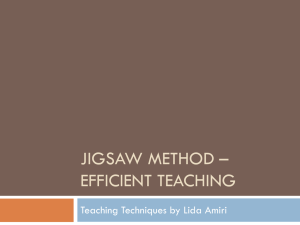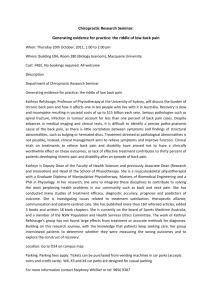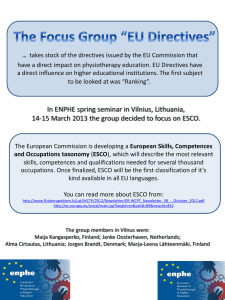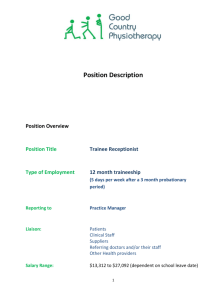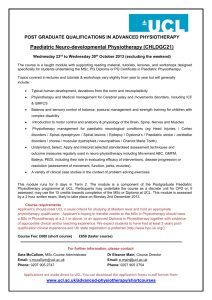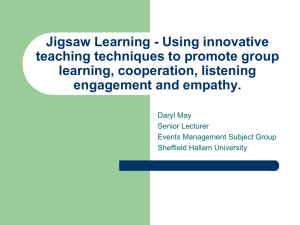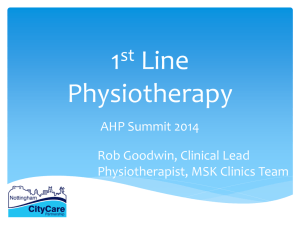Presentación de PowerPoint
advertisement
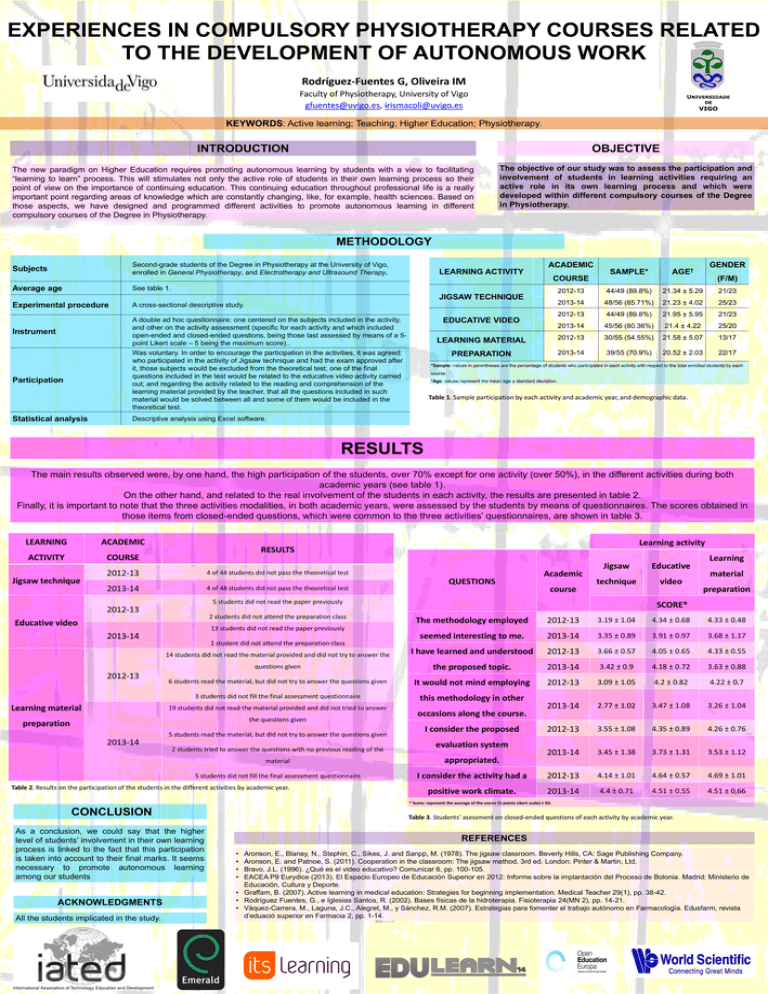
EXPERIENCES IN COMPULSORY PHYSIOTHERAPY COURSES RELATED TO THE DEVELOPMENT OF AUTONOMOUS WORK Rodríguez-Fuentes G, Oliveira IM Faculty of Physiotherapy, University of Vigo gfuentes@uvigo.es, irismacoli@uvigo.es KEYWORDS: Active learning; Teaching; Higher Education; Physiotherapy. INTRODUCTION OBJECTIVE The new paradigm on Higher Education requires promoting autonomous learning by students with a view to facilitating “learning to learn” process. This will stimulates not only the active role of students in their own learning process so their point of view on the importance of continuing education. This continuing education throughout professional life is a really important point regarding areas of knowledge which are constantly changing, like, for example, health sciences. Based on those aspects, we have designed and programmed different activities to promote autonomous learning in different compulsory courses of the Degree in Physiotherapy. The objective of our study was to assess the participation and involvement of students in learning activities requiring an active role in its own learning process and which were developed within different compulsory courses of the Degree in Physiotherapy. METHODOLOGY Second-grade students of the Degree in Physiotherapy at the University of Vigo, enrolled in General Physiotherapy, and Electrotherapy and Ultrasound Therapy. Subjects Average age ACADEMIC SAMPLE* AGE† 2012-13 44/49 (89.8%) 21.34 ± 5.29 21/23 2013-14 48/56 (85.71%) 21.23 ± 4.02 25/23 2012-13 44/49 (89.8%) 21.95 ± 5.95 21/23 2013-14 45/56 (80.36%) 21.4 ± 4.22 25/20 LEARNING MATERIAL 2012-13 30/55 (54.55%) 21.58 ± 5.07 13/17 PREPARATION 2013-14 39/55 (70.9%) 20.52 ± 2.03 22/17 LEARNING ACTIVITY COURSE See table 1. JIGSAW TECHNIQUE Experimental procedure A cross-sectional descriptive study. A double ad hoc questionnaire: one centered on the subjects included in the activity, and other on the activity assessment (specific for each activity and which included open-ended and closed-ended questions, being those last assessed by means of a 5point Likert scale – 5 being the maximum score).. Was voluntary. In order to encourage the participation in the activities, it was agreed: who participated in the activity of Jigsaw technique and had the exam approved after it, those subjects would be excluded from the theoretical test; one of the final questions included in the test would be related to the educative video activity carried out; and regarding the activity related to the reading and comprehension of the learning material provided by the teacher, that all the questions included in such material would be solved between all and some of them would be included in the theoretical test. Instrument Participation Statistical analysis GENDER EDUCATIVE VIDEO (F/M) *Sample: values in parentheses are the percentage of students who participated in each activity with respect to the total enrolled students by each course. †Age: values represent the mean age ± standard deviation. Table 1. Sample participation by each activity and academic year, and demographic data. Descriptive analysis using Excel software. RESULTS The main results observed were, by one hand, the high participation of the students, over 70% except for one activity (over 50%), in the different activities during both academic years (see table 1). On the other hand, and related to the real involvement of the students in each activity, the results are presented in table 2. Finally, it is important to note that the three activities modalities, in both academic years, were assessed by the students by means of questionnaires. The scores obtained in those items from closed-ended questions, which were common to the three activities’ questionnaires, are shown in table 3. LEARNING ACADEMIC ACTIVITY COURSE Jigsaw technique Learning activity RESULTS 2012-13 4 of 44 students did not pass the theoretical test 2013-14 4 of 48 students did not pass the theoretical test QUESTIONS Academic course Jigsaw Educative technique video 5 students did not read the paper previously 2012-13 2 students did not attend the preparation class preparation SCORE* 2012-13 3.19 ± 1.04 4.34 ± 0.68 4.33 ± 0.48 seemed interesting to me. 2013-14 3.35 ± 0.89 3.91 ± 0.97 3.68 ± 1.17 14 students did not read the material provided and did not try to answer the I have learned and understood 2012-13 3.66 ± 0.57 4.05 ± 0.65 4.33 ± 0.55 questions given the proposed topic. 2013-14 3.42 ± 0.9 4.18 ± 0.72 3.63 ± 0.88 6 students read the material, but did not try to answer the questions given It would not mind employing 2012-13 3.09 ± 1.05 4.2 ± 0.82 4.22 ± 0.7 3 students did not fill the final assessment questionnaire this methodology in other 2013-14 2.77 ± 1.02 3.47 ± 1.08 3.26 ± 1.04 2012-13 3.55 ± 1.08 4.35 ± 0.89 4.26 ± 0.76 2013-14 3.45 ± 1.38 3.73 ± 1.31 3.53 ± 1.12 13 students did not read the paper previously 2013-14 1 student did not attend the preparation class Learning material 19 students did not read the material provided and did not tried to answer preparation the questions given 5 students read the material, but did not try to answer the questions given 2013-14 material The methodology employed Educative video 2012-13 Learning 2 students tried to answer the questions with no previous reading of the occasions along the course. I consider the proposed evaluation system material appropriated. 5 students did not fill the final assessment questionnaire I consider the activity had a 2012-13 4.14 ± 1.01 4.64 ± 0.57 4.69 ± 1.01 positive work climate. 2013-14 4.4 ± 0.71 4.51 ± 0.55 4.51 ± 0,66 Table 2. Results on the participation of the students in the different activities by academic year. * Score: represent the average of the scores (5-points Likert scale) ± SD. CONCLUSION As a conclusion, we could say that the higher level of students’ involvement in their own learning process is linked to the fact that this participation is taken into account to their final marks. It seems necessary to promote autonomous learning among our students ACKNOWLEDGMENTS All the students implicated in the study. Table 3. Students’ asessment on closed-ended questions of each activity by academic year. REFERENCES • • • • Aronson, E., Blaney, N., Stephin, C., Sikes, J. and Sanpp, M. (1978). The jigsaw classroom. Beverly Hills, CA: Sage Publishing Company. Aronson, E. and Patnoe, S. (2011). Cooperation in the classroom: The jigsaw method. 3rd ed. London: Pinter & Martin, Ltd. Bravo, J.L. (1996). ¿Qué es el video educativo? Comunicar 6, pp. 100-105. EACEA P9 Eurydice (2013). El Espacio Europeo de Educación Superior en 2012: Informe sobre la implantación del Proceso de Bolonia. Madrid: Ministerio de Educación, Cultura y Deporte. • Graffam, B. (2007). Active learning in medical education: Strategies for beginning implementation. Medical Teacher 29(1), pp. 38-42. • Rodríguez Fuentes, G., e Iglesias Santos, R. (2002). Bases físicas de la hidroterapia. Fisioterapia 24(MN 2), pp. 14-21. • Váquez-Carrera, M., Laguna, J.C., Alegret, M., y Sánchez, R.M. (2007). Estrategias para fomenter el trabajo autónomo en Farmacología. Edusfarm, revista d’eduació superior en Farmacia 2, pp. 1-14.

